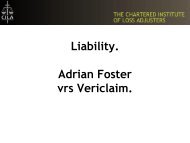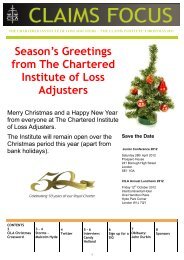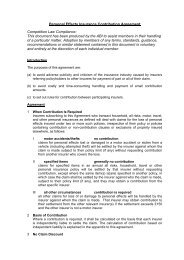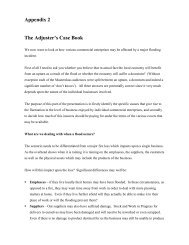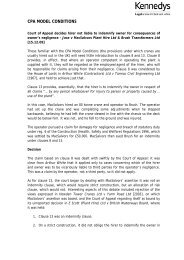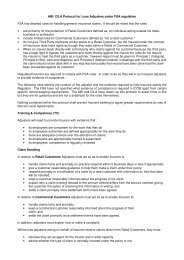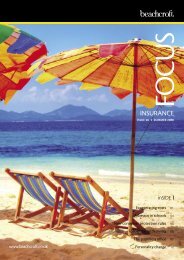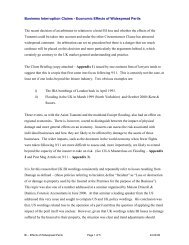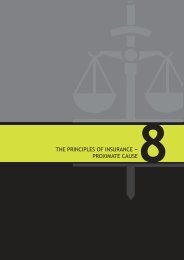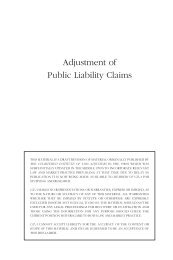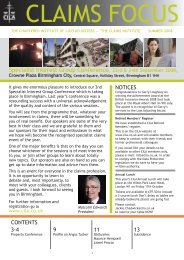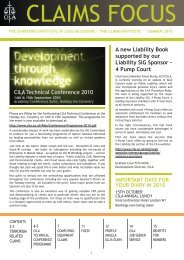Section 1 - CILA/The Chartered Institute of Loss Adjusters
Section 1 - CILA/The Chartered Institute of Loss Adjusters
Section 1 - CILA/The Chartered Institute of Loss Adjusters
Create successful ePaper yourself
Turn your PDF publications into a flip-book with our unique Google optimized e-Paper software.
<strong>Section</strong> 1Suggested Practice for the Conduct <strong>of</strong> Material Damage andBusiness Interruption Insurance in Great Britain and NorthernIrelandCompetition Law Compliance:This document has been produced by the ABI to assist members in their handling<strong>of</strong> a particular matter. Adoption by members <strong>of</strong> any terms, standards, guidance,recommendations or similar statement contained in this document is voluntary andentirely at the discretion <strong>of</strong> each individual member.<strong>The</strong> following Guidance was introduced by the ABI and has not been updated toreflect the Competition Law Compliance statement above. It is entirely voluntary innature and should be construed as such.In this document –(a)(b)application shall not extend to insurances relating to(i) buildings occupied solely as private dwellings including domesticoutbuildings belonging thereto,(ii) household goods and personal effects not used or held by theInsured for trade purposes;the term business interruption insurance relates to insurances covering<strong>Loss</strong> <strong>of</strong> Pr<strong>of</strong>its or Earnings in any form interruption <strong>of</strong> or interferencewith business resulting from destruction <strong>of</strong> damage;(c) “Great Britain” means England, Wales and Scotland, including the Isle<strong>of</strong> Man and the Channel Islands1. Standard Exclusions(i) War and kindred risks(ii) Radioactive Contamination and Explosive Nuclear Assemblies(iii) Terrorism in Northern Ireland1.1 It is suggested that the above risks be excluded from the cover given underMaterial Damage and Business Interruption policies. Appropriate exclusionclauses have been included in the Standard Policy Wordings set out in<strong>Section</strong> 2.(iv)Sonic Bangs1.2 In policies covering Aircraft and/or Explosion, it is suggested that such coverexcludes damage (or loss resulting there from) caused by aircraft and otheraerial devices travelling at sonic or supersonic speeds (see <strong>Section</strong> 2).2 Standard WordingsAmendment Issue No. 5 July 1996
<strong>Section</strong> 12.1 <strong>The</strong> use <strong>of</strong> the under mentioned wordings contained in <strong>Section</strong> 2 issuggested.ABI wishes to reinforce the fact that the Suggested Wordings in theAppendices are recommendations and nothing more. However, theexclusions relating to war and kindred risks, radio active contamination andexplosive nuclear assemblies, terrorism in Northern Ireland and sonic bangswere drafted following legal opinion and it is suggested that membersshould seek their own legal advice on any different wordings.Appendices 1 to 9 Standard Policy WordingsAppendix 10 Material Damage – Special Perils WordingsAppendix 12 Material Damage - Basic Specification WordingAppendix 19 Business Interruption – Special Perils WordingAppendix 20 Business Interruption – Specification WordingsAppendix 21 Business Interruption – Extension Wordings2.2 <strong>The</strong> EC block exemption regulation <strong>of</strong> 21 December 1992 relating to certaintypes <strong>of</strong> agreement in the insurance sector, recognises that the standardpolicy conditions and clauses have the advantage <strong>of</strong> improving thecompatibility <strong>of</strong> cover for the consumer and <strong>of</strong> allowing risks to be classifiedmore uniformly. <strong>The</strong> regulation grants exemption from standard wordings oncondition that they are not binding and serve only as models.ABI would like to draw attention to the fact that wordings are prepared solelyfor the assistance <strong>of</strong> members and that they are not in any way binding.MATERIAL DAMAGE INSURANCES3 Technical StandardsIt is suggested that Members recognise, support and use the technical standardspublished by the <strong>Loss</strong> Prevention Council (LPC) in –(a) the promotion <strong>of</strong> superior standards <strong>of</strong> riskand(b) underwritingso that adverse features <strong>of</strong> risk measured against such standards are penalisedand that in allowing any premium concessions to reflect good features, therequirements <strong>of</strong> the technical standards are observed.A list <strong>of</strong> the suggested LPC technical standards is available from the LPC.4 Average (Underinsurance) ConditionsIt is suggested that insurances covering property on a full value basis incorporatethe principle <strong>of</strong> Average. See suggested wordings in <strong>Section</strong> 2 Appendix 11.5 First <strong>Loss</strong> Covers (Declared Value Clause)It is suggested that First <strong>Loss</strong> covers be provided only for:-(a) Storm, Flood, Escape <strong>of</strong> Water and Sprinkler Leakage(b) Impact(c) Architects’, Surveyors’, Legal and Consultants’ Fees(d) Debris RemovalAmendment Issue No. 5 July 1996
<strong>Section</strong> 1(e) EC and Public Authorities’ Requirements; Early Funding <strong>of</strong> ExistingCommitmentsN.B Where cover is given for any <strong>of</strong> the perils listed in (a) above, the principle <strong>of</strong>Average should be maintained by the use <strong>of</strong> the Declared Value Clause. Seesuggested wording in <strong>Section</strong> 2 Appendix 10. (General Note 1).6 Temporary RemovalWhere an insurance in respect <strong>of</strong> any specified premises is extended to cover theinsured property, other than stock in trade or merchandise, whilst temporaryremoved for cleaning, renovation, repair or other similar purposes in Great Britainand Northern Ireland, the wording in <strong>Section</strong> 2 Appendix 14 is suggested.Where cover is given for property temporarily removed, it is suggested that anappropriate limit be applied – see <strong>Section</strong> 2 Appendix 14.7 Debris RemovalWhen specific reference is made to cover in respect <strong>of</strong> costs incurred in debrisremoval and/or dismantling, demolishing, shoring up or propping in respect <strong>of</strong> anyproperty, the use <strong>of</strong> the wording contained in <strong>Section</strong> 2 Appendix 13 is suggested.8 FoundationsIn arriving at the sum insured for a building, the whole <strong>of</strong> the building or the whole<strong>of</strong> the building or the whole <strong>of</strong> any portion there<strong>of</strong> constituting a separate riskshould be included, although the part below the level <strong>of</strong> the lowest floor can eomitted where appropriate. A similar omission may be made for concretefoundations for machinery which extend above the level <strong>of</strong> the lowest floor. Forsuggested wording – see <strong>Section</strong> 2 Appendix 12 (Note iii)9 Contract priceInsurances on the basis <strong>of</strong> contract price may be granted in the case <strong>of</strong> goods soldbut not delivered and the use <strong>of</strong> the clause detailed in <strong>Section</strong> 2 Appendix 14 issuggested.10 Automatic Fire Alarm InstallationsFire Break Doors and ShuttersAutomatic Sprinkler InstallationsFire Extinguishing AppliancesFor all insurances where one or other <strong>of</strong> the above is installed in accordance withthe LPC Rules referred to in Appendix A and this is reflected in the premiumcharged, the appropriate warranties detailed in <strong>Section</strong> 2 Appendix 15 should beincluded in the Policy.11 Insurances on a Floating or a Stock Declaration BasisSee Appendix B12 Reinstatement Basis <strong>of</strong> Insurance, Inflation Provision Schemes and EC andPublic Authorities’ RequirementsSee Appendix C13 Building Construction and Fire Extinguishments and ProtectionAmendment Issue No. 5 July 1996
<strong>Section</strong> 113.1 For the purpose <strong>of</strong> risk description. Grade 1 (1994) and Grade 2 (1994) <strong>of</strong>the LPC Code <strong>of</strong> Practice for the Construction <strong>of</strong> Buildings, including the definition<strong>of</strong> terms contained on pages 13 and 14 there<strong>of</strong>, should be adopted (See AppendixA here<strong>of</strong>).13.2 Buildings, ranges <strong>of</strong> buildings or parts <strong>of</strong> buildings not separated by FireBreak Walls and/or Fire Break Floors as defined in Grade 1 (1994) and Grade 2(1994), should be treated as one risk.14 Space Heating<strong>The</strong> Classification <strong>of</strong> Heaters detailed in Appendix D has been devised for theassistance <strong>of</strong> underwriters; heaters are classified according to fire hazard withthose classified as A constituting the lowest hazard – heaters classified as Frequire special consideration.15 Fibres15.1 <strong>The</strong> generic classification <strong>of</strong> Fibres detailed in Appendix E has been devisedfor the assistance <strong>of</strong> underwriters; fibres classified as Class I represent thelowest fire hazard15.2 Arrangement can be made for any fibre not included in the classification tobe tested with a view to its inclusion as detailed in Appendix E.16 <strong>The</strong>ft/Impact Claims AgreementThis Agreement is intended to assist in the payment <strong>of</strong> claims for buildings damagewhere there is duplication <strong>of</strong> cover, under a <strong>The</strong>ft insurance and also a MaterialDamage insurance which includes Impact cover (Fire and Perils or “All Risks”) e.g.if vehicles are used to achieve forcible entry into industrial or commercial premises.A list <strong>of</strong> signatories to the Agreement will be provided to all participants, onapplication to the ABI.17 Malicious Damage/<strong>The</strong>ft CoverMalicious Damage cover is regarded as excluding loss or destruction <strong>of</strong> or damageto property actually stolen and any incidental damage directly attributable to thetheft. It does, however, include any other malicious damage caused by intruderswhether or not any element <strong>of</strong> this is involved.<strong>The</strong>ft cover, where affected, may also include incidental damage to other property<strong>of</strong> the Insured if it can be reasonably attributed to, or is in furtherance <strong>of</strong> theft orattempted theft.18 Stock Throughput PoliciesStock Throughput policies are regarded as Marine policies for the purpose <strong>of</strong> theapplication <strong>of</strong> the Marine clause e.g., General Exclusion 5 in Appendix 1 <strong>of</strong> <strong>Section</strong>2.19 Estimated Maximum <strong>Loss</strong> – Non-Sprinklered RisksSee Appendix F.BUSINESS INTERRUPTION INSURANCEAmendment Issue No. 5 July 1996
<strong>Section</strong> 120 Contract <strong>of</strong> IndemnityEvery policy should, so far as may be possible, constitute a contract <strong>of</strong> indemnity21 Bases <strong>of</strong> CoverInsurance on gross pr<strong>of</strong>it or other earnings in any form or part there<strong>of</strong> should be onone <strong>of</strong> the following basis: -21.1 Sum Insured Basis<strong>The</strong> Insurer’s liability is limited to a sum insured representing gross pr<strong>of</strong>it orother earnings in any form or part there<strong>of</strong>. <strong>The</strong> first and annual premiumsare chargeable on the sum insured with subsequent adjustment on thebasis <strong>of</strong> actual gross pr<strong>of</strong>it or earnings.21.2.1 Declaration-Linked Basis<strong>The</strong> insurer’s liability is normally limited to not more than [133.3%] <strong>of</strong> theInsured’s estimated gross pr<strong>of</strong>it or other earnings in any form or part there<strong>of</strong>for the financial year most concurrent with a period <strong>of</strong> insurance(proportionately increased for maximum indemnity periods in excess <strong>of</strong> 12months) and thereafter referred to as the Estimated Gross Pr<strong>of</strong>it, Earningsor Wages. <strong>The</strong> first and annual premium is chargeable on the EstimatedGross Pr<strong>of</strong>it, Earnings or Wages with subsequent adjustment on the basis<strong>of</strong> actual gross pr<strong>of</strong>it, earnings or wages.21.2.2 <strong>The</strong> following provisions should apply: -21.2.2.1 <strong>The</strong> Insured should prior to the inception <strong>of</strong> the insurance andprior to each subsequent renewal advise Insurers <strong>of</strong> theEstimated Gross Pr<strong>of</strong>it etc. (as defined in the policy) for theperiod <strong>of</strong> insurance and that figure should be stated in the policy.<strong>The</strong> policy should incorporate a provision to this effect.21.2.2.2 <strong>The</strong> Insured should apply prior to each renewal (and whensignificant changes are anticipated) adequate underwritinginformation including details <strong>of</strong> current levels <strong>of</strong> earnings andfuture plans and projections, including projections beyond thepolicy year having regard to the maximum indemnity period.21.2.2.3 <strong>The</strong> insured should supply, not later than 6 months after theexpiry date <strong>of</strong> each period <strong>of</strong> insurance, a declaration <strong>of</strong> actualGross Pr<strong>of</strong>it etc. for the relative financial year, confirmed bythe Insured’s Auditors and/or Accountants in respect <strong>of</strong>companies exempt from audit requirements.21.2.3 Failure to comply with any <strong>of</strong> the provisions <strong>of</strong> paragraph 21.2.2 shall rendera case ineligible for the declaration-linked basis <strong>of</strong> cover.21.2.4 This basis should only be adopted for an insurance at its inception or at itsannual renewal.Amendment Issue No. 5 July 1996
<strong>Section</strong> 122 Principles for Policy Wordings22.1 <strong>The</strong> Insured<strong>The</strong> Insured should be so defined that all insured companies arenamed.22.2 Commencement <strong>of</strong> Indemnity PeriodIt is suggested that a policy should not normally be issued with the maximumterm <strong>of</strong> the indemnity period commencing at a later date than the date <strong>of</strong> thedamage, except in the case <strong>of</strong>: -a) a business which is silent, when the commencing date may bemade to coincide with the date on which the business shouldhave started i.e. Advance Pr<strong>of</strong>its:b) an insurance on rent, when the commencement date may bedeferred for a specific period not longer than that periodimmediately after the damage in respect <strong>of</strong> which the rent iseither insured by a fire policy or payable in full in accordance withthe terms <strong>of</strong> a lease or tenancy agreement.22.3 Material Damage Proviso (See Standard Policy Wordings – <strong>Section</strong> 2)Where a deductible or excess applies to the corresponding material damageinsurance, the material damage proviso may be omitted but only as regardslosses for which no liability is admitted under the material damage insurancesolely because <strong>of</strong> the operation <strong>of</strong> the deductible or excess. <strong>The</strong> use <strong>of</strong>wording detailed in <strong>Section</strong> 2 Appendix 20 is suggested for use in thesecircumstances.MATERIAL DAMAGE AND BUSINESS INTERRUPTION INSURANCES23 Long Term UndertakingsSee Appendix G24 Deductibles<strong>The</strong> use <strong>of</strong> the wordings detailed in <strong>Section</strong> 2 Appendix 23 is suggested25 CRESTA/Zoning – Non-Domestic Storm / Flood ExposuresSee Appendix H26 Market Fire Statistics SchemeIt is suggested that all members should participate in the above scheme, thepurpose <strong>of</strong> which is to provide statistics on commercial and industrial materialdamage and business interruption insurance on a trade by trade or business bybusiness basis.Copies <strong>of</strong> the following can be obtained from the Statistical Department <strong>of</strong> ABI: -A. Instructions for Supply <strong>of</strong> dataB. Material Damage – Trade Classification ListC. Business Interruption – Business Classification ListAmendment Issue No. 5 July 1996
<strong>Section</strong> 127 Flue Gas ExplosionInsurers do not regard the “Steam Pressure” Plant exclusion appearing in theStandard Material Damage policy or extension wordings as being applicable wheredestruction or damage is directly caused by the explosion <strong>of</strong> unburnt gases in anypart <strong>of</strong> any such steam pressure plant or in the flues there<strong>of</strong>. However, destructionor damage by any consequent bursting by steam pressure <strong>of</strong> such plant wouldremain excluded.Amendment Issue No. 5 July 1996
<strong>Section</strong> 1APPENDIX AAPPROVED: -Components, constructions, installations and materials that are speciallyconsidered and “Approved” or are the subject <strong>of</strong> specialised Rules or Lists.APPROVED AUTOMATIC FIRE ALARM INSTALLATIONS: -An installation conforming to the Rules for Automatic Fire Alarm Installations forthe protection <strong>of</strong> property.APPROVED AUTOMATIC SPRINKLER INSTALLATIONS: -An installation conforming to the Rules <strong>of</strong> Automatic Sprinkler Installations.APPROVED BREAK DOORS AND SHUTTERS: -A door or shutter conforming to the Rules for the Construction and Installation<strong>of</strong> Fire Break Doors and Shutters. Where Double Fire Break Doors are calledfor, these are defined as two approved doors, one fitted on each side <strong>of</strong> a wallopening.APPROVED FIRE EXTINGUISHING APPLIANCES: -Hydrants, hydraulic hose reels, portable fire extinguishers etc., installed anddistributed in accordance with the Rules for the Provision <strong>of</strong> Fire ExtinguishingAppliances.CEILINGS: -Any non structural material applied or attached to ro<strong>of</strong>s or the underside <strong>of</strong>floors, with or without an intervening air space. An internal coating <strong>of</strong> bitumen,tar, pitch or similar material applied to metal sheeting in the course <strong>of</strong> itsfabrication is to be regarded as structural.FIRE RESISTANCE: -<strong>The</strong> period for which an element <strong>of</strong> structure satisfies the relevant requirementsfor the test for fire resistance specified in B.S.476 : Parts 20-23 : 1989 – FireTests on Building Materials and Structures.LININGS: -Any non structural material applied or attached to walls, ro<strong>of</strong>s or the underside<strong>of</strong> floors, with or without an intervening air space. An internal coating <strong>of</strong> bitument,tar, pitch or similar material applied to metal sheeting in the course <strong>of</strong> its fabricationis to be regarded as structural.NON COMBUSTIBLE: -<strong>The</strong> property <strong>of</strong> a material which satisfies the requirements for noncombustibility when tested in accordance with B.S.476: Part 4 : 1970 – Fire Testson Building Materials and Structures – Non Combustibility Tests for Materials.PROPRIETARY PACKING BLOCK ASSEMBLIES: -Proprietary assemblies consisting <strong>of</strong> a frame and insert blocks through whichelectrical cables and conduits containing electrical conductors pass which havebeen tested in accordance with the heating conditions prescribed in B.S. 476:Amendment Issue No. 5 July 1996
<strong>Section</strong> 1Parts 2—23: 1989 – Fire Tests on Building Materials and Structures, for aperiod <strong>of</strong> two hours and have prevented any direct opening being formedthrough which flames could pass.ROOF: -A ro<strong>of</strong> comprises any framework, decking, insulation and external covering tosuch decking, but excludes any lining as defined.SINGLE STOREY BUILDINGS: -A building consisting only <strong>of</strong> a ground storey, with or without a basement, theceiling <strong>of</strong> which is not more than 1.0m above the lowest point <strong>of</strong> the land levelor ground line <strong>of</strong> the site on which the building stands. Where the ceiling <strong>of</strong> thebasement is more than 1.0m above the lowest point, the floor area <strong>of</strong> thebasement must not exceed 10% <strong>of</strong> the area <strong>of</strong> the ground storey.Where no basement exists, mezzanine and / or gallery floors having anaggregate area not exceeding 10% <strong>of</strong> the area <strong>of</strong> the ground storey areallowed, provided that the space above and below a mezzanine floor and / orgallery is used mainly for the purpose <strong>of</strong> storage and / or <strong>of</strong>fice space.WIRED GLASS: -Glass having a minimum thickness <strong>of</strong> not less than 6mm, a mesh <strong>of</strong> not greaterthan 25mm embedded in it and the squares not exceeding 0.25m squared.Amendment Issue No. 5 July 1996
<strong>Section</strong> 1APPENDIX BINSURANCES ON A FLOATING BASIS1 GeneralAn insurance on a floating basis is one covering buildings or contents or stockeach in one amount over more than one premises or over more than one buildingor group <strong>of</strong> buildings forming a separate exposure.2 PremisesIt is suggested that a list <strong>of</strong> all situations covered by the insurance should(except as regards Outside Locations – see <strong>Section</strong> 2 Appendix 16) be eitheri) incorporated within the policy, orii) detailed in a separate list held by the Insurers.3 DeclarationIt is suggested that prior to the issue <strong>of</strong> any floating insurance declarationsshould be made to the Insurers <strong>of</strong> the current values <strong>of</strong> each <strong>of</strong>: -a)i) Buildingsii) Machinery, Plant and all other Contents (excluding Stock),Giving separate values in respect <strong>of</strong> each building or group <strong>of</strong> buildings forming aseparately rateable range;b) Stock -i) in each building or group <strong>of</strong> buildings forming a separately rateablerange,ii) in the open (if insured),as at the stocktaking on which the last preceding annual statement <strong>of</strong> the Insured’saccounts was based or where this is not possible, a reasonable estimate based onnormal distribution.4 Triennial DeclarationsIt is suggested that similar declarations to those mentioned under 3 aboveshould be furnished triennially.5 LimitsIt is suggested that limits be imposed in respect <strong>of</strong> the liability <strong>of</strong> the Insurer(s)at any one location.6 WordingsFor suggested wordings, see <strong>Section</strong> 2 Appendix 16.INSURANCES ON A STOCK DECLARATION BASISFor suggested wordings, see <strong>Section</strong> 2 Appendix 17Amendment Issue No. 5 July 1996
<strong>Section</strong> 1APPENDIX CINFLATION PROVISION SCHEMESANDPUBLIC AUHTORITIES’ REQUIREMENTSIt is intended that these provisions should apply only to insurances coveringbuildings and contents other than stock in trade.REINSTATEMENT INSURANCEWhere a basis <strong>of</strong> loss settlement under a policy provides for reinstatement in anew condition (on the same or another site) <strong>of</strong> the property damaged or destroyedthe Reinstatement Memorandum A or B (as appropriate) in <strong>Section</strong> 2 Appendix 18is suggested.INFLATION PROVISION – DAY ONE BASISi) Sum Insured – <strong>The</strong> sum insured should be determined as follows:-a) Declared Value – This shall represent the cost <strong>of</strong> reinstatement <strong>of</strong>the property insured arrived at in accordance with paragraph A(a) <strong>of</strong>Reinstatement Memorandum B at the level <strong>of</strong> costs applying at theinception <strong>of</strong> the period <strong>of</strong> insurance (without provision for inflationwhich may operate subsequently), together with, in so far as theinsurance by the item provides, due allowance for -i) the additional cost <strong>of</strong> reinstatement to comply with Public Authorityrequirements,ii) pr<strong>of</strong>essional fees,iii) debris removal costs.<strong>The</strong> Declared Value shall be notified to the Insurers at the commencement<strong>of</strong> each period <strong>of</strong> insurance to which should be addedb) Inflation provision – an amount expressed as a percentage <strong>of</strong> theDeclared Value.ii) Bases <strong>of</strong> Premiumiii) Escalator ClauseIt is suggested that any insurance granted under the provision <strong>of</strong> thisScheme should not be subject to an escalator clauseiv) Capital AdditionsWhere required it is suggested this be provided as follows:-a) adjustable basis – the wording detailed in paragraph 8 <strong>of</strong>Memorandum B in <strong>Section</strong> 2 Appendix 18 is suggested,b) non adjustable basis – an appropriate clause incorporating provisionfor declarations and adjustment should be applied.v) Wording<strong>The</strong> wording <strong>of</strong> Memorandum B (non adjustable or adjustable, asappropriate), in <strong>Section</strong> 2 Appendix 18 is suggested.Amendment Issue No. 5 July 1996
<strong>Section</strong> 1Notes 1: <strong>The</strong> Declared Value should be shown in the Specification inbrackets below the sum insured.2: This scheme should only be applied to an insurance at itsinception or at its annual renewal.INFLATION PROVISION – APPRECIATION IN VALUE CAUSE(ESCALATOR)This provision may be applied regardless <strong>of</strong> whether the insurance is written ona reinstatement basis. Memorandum C in <strong>Section</strong> 2 Appendix 18 is suggested.PUBLIC AUTHORITIES’ REQUIREMENTSProvision may be made in an insurance on a reinstatement basis for:i) the additional cost <strong>of</strong> reinstatement <strong>of</strong> property incurred solely to complywith the requirements <strong>of</strong> EC Bye-Laws legislation or Public Authorities,andii) the interest charges necessarily and reasonably incurred by the insuredfollowing DAMAGE solely to provide the balance <strong>of</strong> any pre-existing fundsset aside for the purpose <strong>of</strong> financing the full cost <strong>of</strong> compliance with anystipulations <strong>of</strong> EC Legislation or Building or other Regulation under orframed in pursuance <strong>of</strong> any Act <strong>of</strong> Parliament or with Bye-Laws <strong>of</strong> anyPublic Authority.<strong>The</strong> use <strong>of</strong> memorandum D1, D2 or E (as appropriate) in <strong>Section</strong> 2 Appendix 18 issuggested and as between Offices in the settlement <strong>of</strong> losses, policies containingthis Memorandum or any other Memorandum providing indemnity <strong>of</strong> a similarnature shall be deemed to be concurrent.Amendment Issue No. 5 July 1996
<strong>Section</strong> 1CLASSIFICATION OF HEATERS1 General1.1 Any electrical equipment for use in flammable and/or explosiveatmospheres shall be <strong>of</strong> flamepro<strong>of</strong> design or otherwise inaccordance with BS5501: Electrical apparatus for potentiallyexplosive atmospheres, with all wiring either in screwed steel conduitor otherwise in accordance with BS5345: Code <strong>of</strong> Practice for theselection, installation and maintenance <strong>of</strong> electrical apparatus for usein potentially explosive atmospheres.1.2 Any chimney or flue pipe shall be constructed <strong>of</strong> non-combustiblematerials1.3 All ducts and lagging shall be non combustible1.4 Combustible material shall not be situated within-1.4.1 a distance <strong>of</strong> three times the external diameter <strong>of</strong> a chimney orflue serving a solid fuel or oil burning appliance unless thewalls <strong>of</strong> the chimney or flue consist <strong>of</strong> solid non-combustiblematerials not less than 200mm thick; where there iscombustible material above the chimney or flue the thickness<strong>of</strong> non combustible material shall not be less than 300mm.1.4.2 50mm <strong>of</strong> a chimney or flue serving a gas appliance and wherethe chimney or flue passes through a ro<strong>of</strong>, floor, ceiling, wall orpartition containing combustible material the flue pipe shallpass through a non-combustible sleeve separated from thechimney or flue by an air space <strong>of</strong> not less than 25mm.1.4.3 1m <strong>of</strong> a space heating appliance.1.5 Appliances shall use only the type(s) <strong>of</strong> fuel for which they aredesigned.1.6 Where the system or appliance burns fuel <strong>of</strong> an unconventionalnature e.g. waste oil, trade waste, etc…,the system or appliance shallbe classed F.1.7 Where the following Recommendations are applicable to the systemor appliance, failure to comply with the Recommendations may causethe system or appliance to be down-graded:1.7.1 “Recommendations for Liquefied Petroleum Gas”.1.7.2 “Recommendations for Oil Fired Installations”1.7.3 “Recommendations for Portable and Transportable SpaceHeaters”.2 Central Heating SystemsWhere the heated medium is delivered to the space or spaces to beheated via pipes or ducts, usually from a single heating source, the heatershall incorporate, where applicable, both:-(i) a remote fuel source and(iii) a flame failure device, an overheat cut-out device, a fan failure cut-outdevice and a fire valve.Amendment Issue No. 5 July 1996
<strong>Section</strong> 1Relevant systems incorporating only (i) and (ii) shall be downgraded by oneclass.Relevant systems incorporating neither (i) nor (ii) shall be downgraded bytwo classes.2.1 Segregated SystemsWhere the heater is segregated from the rest <strong>of</strong> the building byseparating elements providing not less than two hours’ fire resistance(including self closing doors) in accordance with “Code <strong>of</strong> Practice forthe Construction <strong>of</strong> Buildings, Grade 1 (1994) and Grade 2 (1994)” orby being in the open.2.1.1 Indirect fired systems that incorporated a heat exchanger,where any products <strong>of</strong> combustion are exhausted to the openair and do not enter the heated space.2.1.1.1 Where hot water or steam enters a system <strong>of</strong> pipesat a temperature not exceeding 120 degreescentigrade……………………………. A2.1.1.2 Where hot water or steam enters a system <strong>of</strong> pipesat a temperature which exceeds 120 degreescentigrade…………………………… B2.1.1.3 Where heated air reaches the space(s) to be heatedvia a system <strong>of</strong> ducts ………………….C2.1.2 Direct fired systems that do not incorporate a heat exchanger,where any products <strong>of</strong> combustion enter the heated space.2.1.2.1 Heated by electricity ……………………………B2.1.2.2 Fired by gas or oil……………………………….C2.2 Non-Segregated SystemsWhere the heater is sited other than in 2.12.2.1 Indirect fired systems as described in 2.1.12.2.1.1 Heated by electricity ……………………………B2.2.1.2 Fired by gas, oil or solid fuel…………………. .C2.2.2 Direct fired systems as described in 2.1.2 shall beclassified under <strong>Section</strong>s 3 to 6.Amendment Issue No. 5 July 1996
<strong>Section</strong> 1FixedAPPENDIX DPortable orTransportable3 ELECTRICAL APPLIANCES(Excluding those covered by 2)3.1 Electric under floor or ceiling heating with heatingelements totally embedded in cement or concrete… A -3.2 Heaters with enclosed elements, e.g. fluid filledRadiators and tubular heaters3.2.1 Incorporating an overheat cut-out device… B C3.2.2 Other than in 3.2.1 C D3.3 Forced convection heaters, e.g. fan heaters3.3.1 Incorporating a fan failure cut-out deviceAnd/or an overheat cut-out device B C3.3.2 Other than 3.2.1 C D3.4 <strong>The</strong>rmal storage heaters3.4.1 Incorporating an overheat cut-out device C -3.4.2 Other than in 3.4.1 D -3.5 Heaters with exposed elements or elements sheathedIn ceramic, silica or metal D E4 GAS APPLIANCES and OIL APPLIANCES(Including catalytic heaters but excluding heaters covered by 2)4.1 Appliances having both4.1.1 A remote fuel source and4.1.2 A flame failure device, an overheat cut-outDevice, a fire value, and where relevant, aFan failure cut-out device C D4.2 Appliances complying with either 4.1.1 or 4.1.2 D E4.3 Other than in 4.1 or 4.2 E F5 SOLID FUEL APPLIANCES(Excluding those covered by 2)5.1 Fireplaces and heaters (other than braziers) on aFloor or base <strong>of</strong> concrete or brick not less than125mm thick and <strong>of</strong> adequate area D -5.2 Other than in 5.1 F F6 MISCELLANEOUS6.1 Any form <strong>of</strong> heating not specified above and anyForm <strong>of</strong> heating not conforming to paragraphs1.1, 1.2, 1.3, 1.4 and 1.5 F FAmendment Issue No. 5 July 1996
<strong>Section</strong> 1APPENDIX ECLASSIFICATION OF FIBRESCLASS INatural FibresHairNatural silk (white orcultivated)WoolMan-made FibresAcetateAcrylicAlginateChlor<strong>of</strong>ibreFluor<strong>of</strong>ibreGlassfibreModacrylicNylon (Polyamide)PolyesterPolyethylenePolypropyleneProtein (regenerated)TriacetateCLASS IINatural FibresCotton and all vegetable fibre(other than in Class I)Natural silk (brown or tussah)Man-made FibresCuproModal ViscoeNOTE 1:<strong>The</strong> classification <strong>of</strong> each fibre is understood to include tops or noils derivedtherefrom.NOTE 2:Any fibre not included in the list <strong>of</strong> generic classes should be regarded as a ClassII fibre pending submission for testing and classification in accordance with thefollowing:-(a) a 2.25 kilogram sample <strong>of</strong> the fibre must be submitted directly by theOffice concerned to the Department <strong>of</strong> Textile Industries at theUniversity <strong>of</strong> Leeds for the appropriate tests to be carried out and, atthe same time, inform the Secretary <strong>of</strong> the Property Committee <strong>of</strong> theAssociation <strong>of</strong> British Insurers that they have done so;(b) the Department <strong>of</strong> Textile Industries <strong>of</strong> the University <strong>of</strong> Leeds toprepare the necessary summaries <strong>of</strong> the tests;(c) the summaries when received by the Secretary to be examined bythe Operations Manager <strong>of</strong> the <strong>Loss</strong> Prevention Technical Centreand his recommendations regarding classification to be broughtbefore the Fire Panel <strong>of</strong> the Property Committee. In the event <strong>of</strong> theFire Panel having no comments thereon, the recommendations to bepromulgated by the appropriate amendment to the above list.Amendment Issue No. 5 July 1996
<strong>Section</strong> 1ESTIMATED MAXIMUM LOSS– NON SPRINLERED(MATERIAL DAMAGE)SUGGESTED DEFINITIONAn estimation <strong>of</strong> the maximum loss which could reasonably be sustained from thecontingencies under consideration, as a result <strong>of</strong> a single incident considered to bewithin the realms <strong>of</strong> probability taking into account all factors likely to increase orlessen the extent <strong>of</strong> the loss, but excluding such coincidences and catastropheswhich may be possible but remain unlikely.CommentaryUnless otherwise stated: -(a) <strong>The</strong> operating peril is normally fire and/or explosion.(b) In deciding the extent <strong>of</strong> the building(s) or area to be considered for theestimated maximum loss. Fire Break Walls containing Fire Break orother doors are to be ignored.(c)(d)Multiple seat incidents are excluded.Fire Brigade attendance and fire fighting within reasonable expectationsis assumed.(e) An adequate and reliable supply <strong>of</strong> water is available for fire fighting.(f)(g)Sprinkler protection and other fixed extinguishing systems are ignored.Automatic fire detection systems are considered subject to effectiveresponse and maintenance.PRESENTATION OF EMLIt is suggested that when EMLs are being specified (e.g. in survey reports) they aresupported or accompanied by inclusion <strong>of</strong>:-<strong>The</strong> ABI suggested definition stated in full or reference made thereto<strong>The</strong> operating peril<strong>The</strong> range <strong>of</strong> buildings/property considered to represent the target risk<strong>The</strong> EML percentage and monetary equivalent if requiredBrief explanation <strong>of</strong> the methodology used clearly defining the fire spread anddamage scenario(s):-• Explanation <strong>of</strong> features which will assist fire spread, e.g. linings, fire load,flammables etc.• Identifying features which will slow/prevent fire spread e.g.compartmentation, low fire load, non-combustible construction.METHODOLOGYAmendment Issue No. 5 July 1996
<strong>Section</strong> 11. Estimated Maximum <strong>Loss</strong> (EML) assessments are normally onlyrequired for the target risk, i.e. the single building or group <strong>of</strong> buildingsestimated to produce the largest monetary loss.Stock and machinery in the open and in close proximity may need to beconsidered.2. <strong>The</strong> EML assessment will, in the majority <strong>of</strong> cases, be based on the fireand/or explosion risk but other contingencies should not be overlookede.g. Storm, Flood and Subsidence.3. <strong>The</strong> amount for consideration in assessing the EML is that representedby the Total Sums Insured (or in the case <strong>of</strong> “blanket/floating items”, theestimated maximum values) on Buildings, Rent, Contents and Stock inany single building or group <strong>of</strong> communicating buildings comprising arange from which a fire would not spread to affect other insured propertyexcept in the most exceptional circumstances.Such a building or range <strong>of</strong> buildings will be detached or separated fromother buildings by an unpierced Fire Break Wall constructed as detailedin the LPC Code <strong>of</strong> Practice for the Construction <strong>of</strong> Buildings. Any suchwall containing Fire Break or other doors will be ignored for this purpose.Exposure from closely adjacent buildings or property in the open mayresult in more than one building or range <strong>of</strong> buildings being combined t<strong>of</strong>orm the target risk.<strong>The</strong> amount for consideration will also be affected by any concentration<strong>of</strong> value.Where Pr<strong>of</strong>essional Fees and/or Debris Removal Costs are insured byseparate first loss items, these sums insured are to be included in full.4. <strong>The</strong> EMLs will be assessed from the amount identified for considerationtaking account <strong>of</strong> the circumstances which are reasonably likely to occur.5. EMLs will be expressed separately as a percentage <strong>of</strong> the total suminsured (or estimated maximum value) on each <strong>of</strong> the Buidings. Rent.Contents and Stock at the premises. <strong>The</strong> percentage for any first lossitems will normally be 100%.Monetary EMLs may be provided in support <strong>of</strong> the percentages.6. In normal circumstances where an EML is judged to be in excess <strong>of</strong> 80%a total loss should be assumed.Amendment Issue No. 5 July 1996
<strong>Section</strong> 1APPENDIX GLONG TERM UNDERTAKINGSIt is suggested that in return for an undertaking by the Insured to <strong>of</strong>fer annuallyfor a period <strong>of</strong> not less than 3 years the insurance on the terms and conditionsin force at the expiry <strong>of</strong> each period <strong>of</strong> insurance and to pay the premiums inadvance a discount be allowed <strong>of</strong>f the net premium.It is suggested that a wording affirming the undertaking by the Insured isinserted in the policy (see <strong>Section</strong> 2 Appendix 22), and repeated for eachsucceeding long term period.<strong>The</strong> obligations <strong>of</strong> an Insured under a current long term undertaking should notbe waived, except where –(a)(b)(c)parties to the undertaking enter into a new undertaking provided allthe insurances in the cancelled undertaking are included in the newundertaking,the Insured’s interest in the property and/or business insured hasceased.<strong>The</strong> property has been removed to other premises.Notes 1: As regards (b) above the following principles should apply where onecompany is taken over by another –(i)(ii)(iii)the purchase <strong>of</strong> a business means legally only that shares have beensold by one party to another,if the company continues to exist as an entity, i.e. is not wound up orliquidated, its obligations are in no way affected by change in theownership <strong>of</strong> shares,it follows that it is immaterial whether the purchaser acquires aminority, majority or complete share ownership so far as concernsthe validity <strong>of</strong> the long term undertaking.2: Reductions in sums insured during the currency <strong>of</strong> the undertakingshould only be allowed when they correspond to a reduction in thevalue <strong>of</strong> the property or in the business. Reductions in sums insuredshould not be <strong>of</strong>f set against a new interest or an increase in existinginterest in any other insurance whether Material Damage or BusinessInterruption.3: Alterations in the length <strong>of</strong> the maximum term <strong>of</strong> an indemnity periodare not a breach <strong>of</strong> an undertaking.Long term undertakings are freely negotiated and legally binding contracts.An <strong>of</strong>fer by an Insurer during the currency <strong>of</strong> an undertaking involving alower premium or less onerous conditions does not constitute a valid reasonAmendment Issue No. 5 July 1996
<strong>Section</strong> 1for breaking an undertaking. <strong>The</strong>se views are supported by the BritishInsurance and Investment Brokers’ Association.Amendment Issue No. 5 July 1996
<strong>Section</strong> 1APPENDIX HABI/LIRMA GUIDELINES FOR THE PROVISION OF CRESTA/ZONING INRESPECT OF UK NON-DOMESTIC STORM/FLOOD EXPOSURES(Starting by 30 September 1994)1. Introduction1.1 In liaison with LIRMA it has been agreed that, where direct insurers havebeen asked to supply exposure figures for storm/flood sums insured bylocation (Postcode Sector), the following basis is suggested.2. Parameters2.1 <strong>The</strong> supply <strong>of</strong> information relates to insurances in respect <strong>of</strong> Stormonly,or Storm/flood (without, at this stage, distinguishing between them)under Appendices 2,3,5,6,7 or 8 <strong>of</strong> <strong>Section</strong> 2 including CollectivePolicies (<strong>Section</strong> 3)2.2 Data to comprise:(a) Location to be identified by postcode section (e.g. EC2V for 51Gresham Street, London). NB <strong>The</strong>re are nearly 9,000 postcodesectors.(b) Exposure amount for material damage insurance- for Day One Insurances ) if possible an- the Declared Value ignoring inflation ) indication should beprovision %) given <strong>of</strong> the) approximate division- for other Insurances ) between each basis <strong>of</strong>- the sum insured ) exposureDeductibles/excesses are to be ignored(c) Exposure amount for business interruption insurance- for EGP/Rev Insurances ) if possible an- the EGP/Rev ignoring 33.3% uplift ) indication should be) given <strong>of</strong> the- for other Insurance ) approximate division- the sum insured ) between each basis <strong>of</strong>) exposureDeductibles/excesses are to be ignoredNote: Exposures are companies’ own proportion only and will normallybe net i.e. after reinsurance.(d) Separate figures to be supplied for each <strong>of</strong>- Buildings- Contents- Combined Buildings/Contents, where cover is written on this basisonly and a split is not available- Business InterruptionAmendment Issue No. 5 July 1996
<strong>Section</strong> 1(e)For multi location exposures ie material damage insurances on afloating/blanket basis or overall business interruption covers. Undereach <strong>of</strong> the categories in (d) above, every exposure actually orestimated to be 5% or more <strong>of</strong> the item’s sum insured/Day oneDeclared Value or sum insured/Estimated Gross Pr<strong>of</strong>it in anypostcode sector. Should be identified and allocated to that sector.Lesser exposure values may be aggregated into a National totalfigure for each <strong>of</strong> the categories under (d) (designated asmiscellaneous).Note: <strong>The</strong> number <strong>of</strong> exposures under each category ((d) above) in eachlocation should be “counted”.3 Data Supply to Reinsurers3.1 <strong>The</strong> data should be aggregated as follows (separately for each postcodesector) and probably supplied on an ASCII disk.PostcodeSectorBuildings Contents Building/Contents BusinessInterruptionAggregate <strong>of</strong>For Day OneInsurances – DVFor otherinsurances – SIAggregate <strong>of</strong>For Day OneInsurances –DVAggregate <strong>of</strong>For Day OneInsurances – DVAggregate <strong>of</strong>For ECP/Revinsurances- EGP/REV£…. £…. £…. £….For otherinsurances – SIFor otherinsurances – SIFor otherinsurances – SI* Count…. * Count…. * Count…. * Count….* Count = number <strong>of</strong> exposures3.2 It is suggested that appropriate systems provide for the annual up dating<strong>of</strong> the above.3.3 An overall indication <strong>of</strong> the general level <strong>of</strong> inflation provision percentageunder the Day One covers should be provided.Amendment Issue No. 5 July 1996



